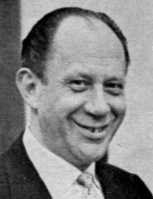
Ellington, Henderson and the Casa Loma Orchestra
The
History of British Jazz
Fred
Elizalde
The
Orpheans and Havana bands
Bert Ambrose
The
arrival of the Swing Era
Spike
Hughes
Ellington,
Henderson and the Casa Loma orchestra Smaller
groups
Nat
Gonella and Tommy McQuater
Jazz-orientated
groups
Adrian
Rollini
Venuti
and Lang
My
musical training
The
1926 album
Ensemble
Studio 4
Gramophone
techniques
This
thing called jazz
Dance
versus straight
Chisholm
and McQuater
American
influence on recordings
The
freeblowers
Human
emotion
Harps,
Stanelli and Leslie Clare
Synthesizers
and Stokowski
Player
pianos
Stage
bands
During the latter five years of the period with which I have so far been dealing (1924- 1935) many important recordings had reached us from the US, apart from those of the orchestras of Duke Ellington, Fletcher Henderson and the Casa Loma already mentioned. These included records by such groups as those of Buster Bailey, Teddy Wilson, Coleman Hawkins, Luis Russell, Bennie Morton, Teddy Hill, Benny Carter and Don Redman, whilst Louis Armstrong maintained a steady output.
There were a host of others that could be similarly listed, but it is essential that I deal here mainly with the British bands of the various periods. However, I recall some records by the Red Nichols Five Pennies made in 1930, and which reached us in the early part of 1931, that had considerable influence upon all those interested in the progressive development of jazz. For this reason I shall give them a special reference. I have already referred to the discs cut in 1929 by Miff Mole's Molers, of "That's A Plenty" and "I've Got A Feeling I'm Falling", in which the drumming of Stan King almost revolutionised the playing of most of the leading British drummers.
The Nichols recordings of only a year or so later had further far- reaching affects. First of all, we were hearing the work of Gene Krupa properly recorded for the first time and, his style being substantially different to that of Stan King, the style of British drummers was again affected, in many cases fairly quickly, only Bill Harty remaining a Stan King devotee right up to the time when he left Britain to settle in the US in 1934. In addition to Krupa, however, the general style of the Nichols group had undergone considerable change and, although still described as the "Five Pennies", the personnel had in fact been increased to twelve and sometimes more players.
A typical example of the work of the group at this period was the recording of "After You've Gone". Which was the track in which Krupa probably had a greater influence than the remainder but, with a personnel that included Nichols, Manny Klein, Jack Teagarden, Glenn Miller, the Rusin brothers, Babe and Jack, on tenor saxophone and piano respectively, and Jimmy Dorsey, it is obvious that their influence extended far wider than the percussion department. Other good examples of the group's work, with slight variations of personnel, were "The Sheik Of Araby", in which there was some glorious duet work by Teagarden and Miller, Benny Goodman replaced Jimmy Dorsey and Joe Sullivan replaced Jack Rusin, "Just A Crazy Song" and "You Rascal You"—in both of which Miller was the only trombonist.
The band had a punching, driving style that, in my opinion, represented one of the most important phases in jazz development in the States. In turn, it had enormous affect in Britain but, as already described, gave way to the influence in the years immediately following of the more disciplined styles of the Casa Loma and Ellington orchestras. Meantime there had been a further visit to Europe of Louis Armstrong in 1933, when he again employed local musicians. In 1934 he made yet a third visit, which was to be his last for some twenty-two years.
In the same year Cab Calloway's Orchestra played a brief season at the London Palladium, but failed to capture the enthusiasm of British musicians because it served mainly as an accompaniment for the singing and general fooling around of its leader. There was nevertheless some fine playing to be heard in the brief moments when various corner men were given an opportunity to demonstrate their style. But who, at that time, could hope to follow Ellington? Had Calloway come to Britain just three years later the story might have been somewhat different, for by then the orchestra played with much more style and the featured first tenor saxophonist was none other than Leon "Chu" Berry. After 1935, however, there were to be no more American bands visiting Britain for many years, for reasons I shall be explaining in detail a little later.
In 1934 we enjoyed a visit from Joe Venuti, supported by his then new guitarist Frank Victor; Eddie Lang having died in the previous year. During their two weeks at the Palladium they were backed by the British orchestra of Teddy Joyce, a Canadian showman/ leader who lived in Britain for a number of years prior to his death, touring mainly in variety and for one- night stands. Whilst in Britain, Venuti and Victor cut two sides for HMV, the titles being "Hell's Bells And Hallelujah" and "Satan's Holiday", in which they were supported by Arthur Young on piano, Don Barrigo on tenor and Doug Lees on bass, with excellent results. These tracks stand up well after forty years— which will surprise nobody familiar with Venuti's unique brilliance, or who was present at his Hammersmith Gaumont concert in the late 'sixties when, supported by Barney Kessel, he had the audience literally on its feet and raving! For me, Venuti is the David Oistrakh of jazz.